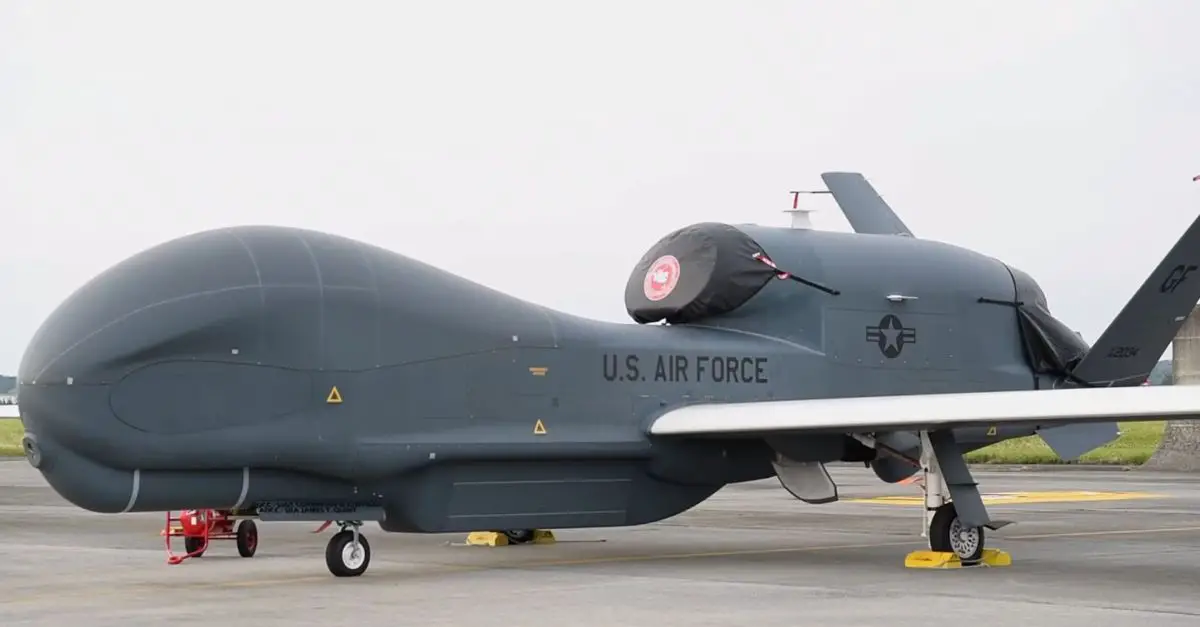Breaking News
US RQ-4 Global Hawk Temporarily Deploys to England RAF air base.
An American RQ-4 Global Hawk arrived at the Royal Air Force base in Fairford, England, on Thursday for a temporary deployment, as part of efforts by the U.S. Air Forces in Europe - Air Forces Africa to diversify operational sites and enhance integration with NATO allies. This marks the first deployment of a U.S. RQ-4 in England. The deployed RQ-4 will conduct operations in international and allied airspace in accordance with international norms and standards.
Follow Army Recognition on Google News at this link

USAF RQ-4 Global Hawk , a HALE observation drone at Yokota Air Base, JApan , 2023 (Picture source: US Air Force)
The deployment also marks the next step in the implementation of USAFE-AFAFRICA's Agile Combat Employment concept, which allows aircraft to be dispersed from typical operating locations to alternative airfields to improve survivability.
The 501st Combat Support Wing at RAF Fairford has regularly supported similar deployments, including when U.S. Air Force B-52 Stratofortress aircraft operated from RAF Fairford for Bomber Task Force 24-3 in June. The support and execution of these missions demonstrate the U.S.'s commitment to NATO allies and partners and set the conditions for possible future operations within the U.S. European Command's area of responsibility.
The Global Hawk, with the callsign Forte 12, landed at Fairford Air Base shortly before 10:30 PM local time on August 22, after a nearly 24-hour flight from Sigonella, Italy, that traversed much of Eastern Europe and Finland before flying west across Sweden and Norway to the UK. The unmanned aircraft, built by Northrop Grumman, used newly segregated airspace to descend from its operational altitude of over 50,000 feet to land at Fairford.
According to the UK Civil Aviation Authority (CAA), the flight is the first of two planned for August to ensure that flight operations comply with the conditions set by the regulator when it finally gave the green light for U.S. high-altitude, long-endurance drone flights from the airfield in February. The UK Ministry of Defence had requested as early as November 2021 to modify the airspace to allow drone flight operations from Fairford. Since then, the CAA has undertaken an extensive consultation exercise to allow the creation of the giant segregated airspace complex EDG218, which will enable aircraft to climb and descend to and from their operating altitude. Recent documents suggest concerns that the airspace might affect operations at Birmingham Airport, 50 miles to the north.
The complex was created with a three-hour window to accommodate arrivals and departures but also to ensure the airspace is active long enough to allow for emergency or contingency scenarios. Activation will be made by notification to aviators at least 24 hours before operations. The airspace modifications were initially developed to support NATO's Agile Combat Employment concept to generate sustained air combat power through dispersal, but now, drones will operate from the airfield about 2 to 3 times a week, primarily during nighttime hours to minimize the impact on commercial air traffic, according to the airspace modification documents.
The region's skies are used 24 hours a day by aircraft landing and departing from London airports and transiting Europe for transatlantic routes as well as flights to Southern Ireland. However, the airspace modification documents indicate that the UK Ministry of Defence considers drone flights "strategically and operationally vital" for the government, contributing to strengthening bilateral relations with the U.S. and NATO.
RAF Fairford currently hosts an expeditionary reconnaissance squadron operating the Lockheed U-2 and is regularly used by routine deployments of the Air Force Global Strike Command's Bomber Task Force in the European theater, having recently hosted a Boeing B-52 detachment in May. The airfield also hosts the annual Royal International Air Tattoo. It is expected that the presence of drones will eventually replace the U-2s at Fairford when this type of aircraft is retired from U.S. Air Force use.
The U.S. Air Force already regularly operates RQ-4s from the Naval Air Station in Sigonella, Italy, with many flights conducted over the Black Sea to monitor Ukraine, alongside Global Hawks operated by NATO and MQ-4 Tritons operated by the U.S. Navy.


























